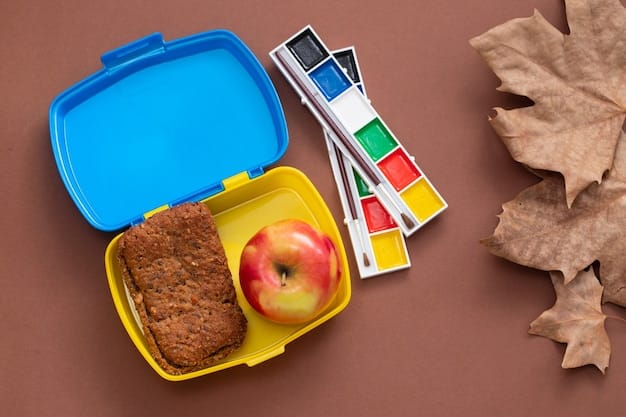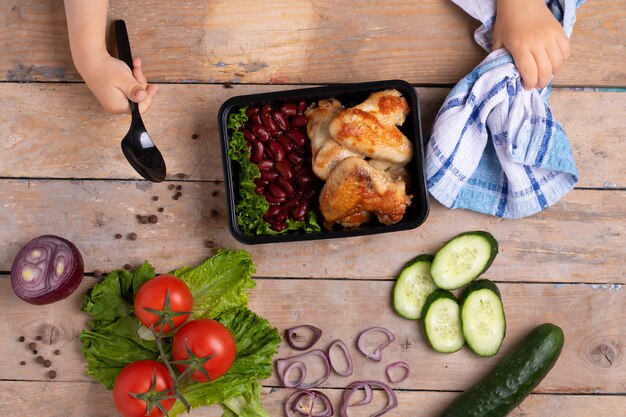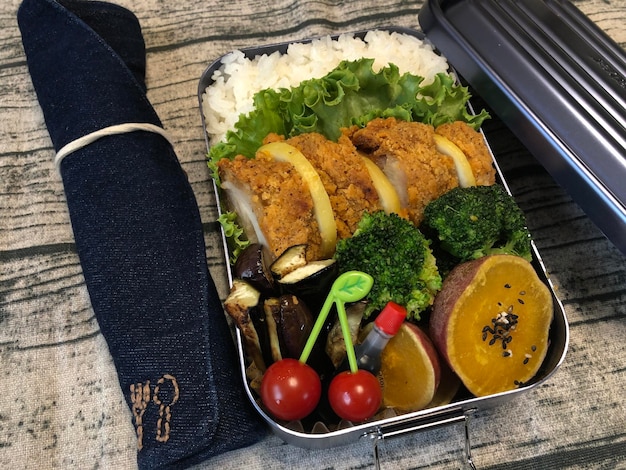Healthy Lunchbox Ideas for Kids: Nutritious Recipes for School

Healthy lunchbox ideas for kids involve creating balanced, appealing meals that adhere to school nutrition guidelines, incorporating fruits, vegetables, lean proteins, and whole grains to fuel their day and promote healthy eating habits.
Packing a lunchbox that’s both healthy and appealing to kids can feel like a daily challenge. You want to ensure they’re getting the nutrients they need to thrive in school, but also pack something they’ll actually enjoy eating. Discover some creative and nutritious healthy lunchbox ideas for kids: recipes that meet school nutrition guidelines that combine taste and health effortlessly.
Why Healthy Lunchboxes Matter
Ensuring your child’s lunchbox is packed with nutritious options is about more than just filling their bellies. It’s a direct investment in their overall well-being. Here’s why those healthy lunchbox ideas for kids are so important:
Fueling Learning and Focus
Nutrient-rich foods provide sustained energy, promoting better concentration and cognitive function throughout the school day. Avoiding sugary snacks and processed foods helps prevent energy crashes that can lead to restlessness and difficulty focusing.
Supporting Growth and Development
A healthy lunchbox can supply essential vitamins, minerals, and other nutrients necessary for physical growth, bone health, and immune function. A balanced diet supports overall development and helps prevent nutritional deficiencies.
- Improved Academic Performance: Children with healthy diets perform better academically.
- Better Mood and Behavior: Balanced nutrition contributes to emotional stability.
- Long-Term Health: Healthy habits formed early can reduce the risk of chronic diseases later in life.
Healthy lunchboxes aren’t just about packing food; they’re about setting a foundation for a lifetime of healthy choices and ensuring your child is equipped to succeed both in and out of the classroom.
Understanding School Nutrition Guidelines
Navigating school nutrition guidance can sometimes feel like a chore. Most schools adhere to federal guidelines established to promote children’s health and well-being. Here’s a breakdown of what those healthy lunchbox ideas for kids should incorporate, according to these standards:
Key Nutritional Components
School nutrition rules typically prioritize balanced meals that include components from all five major food groups: fruits, vegetables, grains, protein, and dairy. These items should be proportioned to offer a variety of nutrients without excess calories, saturated fats, or sodium.
Common Restrictions and Recommendations
Many schools prohibit or restrict certain items, such as sugary drinks, candy, and foods high in saturated and trans fats. They recommend whole grains over refined grains, lean proteins over processed meats, and fresh or minimally processed foods whenever possible.

- Whole Grains: Choose whole-wheat bread, brown rice, or quinoa.
- Lean Proteins: Opt for turkey, chicken, fish, or beans.
- Fresh Produce: Pack fruits and vegetables in every lunch.
- Low-Fat Dairy: Include yogurt, cheese, or milk alternatives.
By understanding these guidelines and restrictions, you can ensure that your healthy lunchbox ideas for kids not only delight their taste buds but also meet the nutritional standards set by their school.
Creative and Kid-Friendly Recipes
Now for the fun part: crafting those healthy lunchbox ideas for kids. It’s all about getting creative and involving your children in the process. Here are a few recipes that are both nutritious and kid-approved:
Turkey and Avocado Wraps
A simple yet satisfying option. Spread mashed avocado on a whole-wheat tortilla, add sliced turkey, spinach, and a sprinkle of cheese. Roll it up tightly and slice into bite-sized pieces.
DIY Pizza Lunchables
A fun and interactive meal. Pack whole-wheat pita bread, tomato sauce, shredded mozzarella cheese, and their favorite pizza toppings (pepperoni, veggies) in separate containers. Let them assemble their own mini pizzas at lunchtime.

- Chicken Salad Sandwiches: Use Greek yogurt instead of mayonnaise for a healthier twist.
- Quesadillas: Fill whole-wheat tortillas with beans, cheese, and veggies.
- Pasta Salad: Combine whole-wheat pasta with grilled chicken, vegetables, and a light vinaigrette.
These recipes show that you don’t have to sacrifice taste for nutrition. By getting creative with ingredients and presentation, you can make healthy lunchbox ideas for kids that they’ll actually look forward to eating.
Tips for Packing Efficient and Appealing Lunchboxes
Packing a lunchbox that’s both healthy and appealing requires more than just great recipes. It also needs a few tricks and strategies. These tips will ensure your healthy lunchbox ideas for kids are a success.
Presentation Matters
Kids eat with their eyes. Use colorful containers, bento boxes, and cookie cutters to make food more visually appealing. Cut sandwiches into fun shapes, arrange fruits and vegetables artfully, and add a small, handwritten note or sticker for an extra touch of excitement.
Involve Your Kids
Let them participate in the planning and packing process. Ask for their input on what they’d like to include, and let them help with age-appropriate tasks like washing fruits or assembling sandwiches. When kids feel involved, they’re more likely to eat what’s in their lunchboxes.
Make sure you get your little ones involved. Even small children may be involved in snack selection, vegetable washing, and other safe jobs.
Packing healthy lunchboxes doesn’t have to be tedious when you follow some important recommendations.
- Pack Smartly: Use ice packs to keep cold foods cold and insulated containers to keep hot foods hot.
- Prep Ahead: Save time by prepping ingredients on the weekend.
- Keep it Simple: Don’t overcomplicate things. Choose a few key items that you know your child will eat, and build from there.
With these tips, your healthy lunchbox ideas for kids will be not only nutritious but also enjoyable and stress-free.
Handling Picky Eaters and Food Allergies
Dealing with picky eaters or managing food allergies can add layers of complexity to packing healthy lunchbox ideas for kids. Tailoring lunches to meet specific needs requires awareness, creativity, and clear communication. Here are a few strategies to navigate these challenges:
Addressing Picky Eating Habits
Introduce new foods gradually and pair them with familiar favorites. Offer small portions of new items alongside foods you know your child enjoys. Avoid pressuring them to eat everything, which can create negative associations with food. Instead, focus on creating a relaxed and positive mealtime environment.
Managing Food Allergies
Work closely with your child’s school to ensure that their lunchbox is safe and that staff members are aware of their allergies. Avoid cross-contamination by using separate cutting boards, utensils, and containers. Clearly label all lunchbox items with your child’s name and any relevant allergy information. Consider packing a backup meal or snack in case of accidental exposure.
Picky eating or food allergies don’t have to be overwhelming.
- Communicate: Maintain open dialogue with your child and their school.
- Adapt: Adjust recipes and lunchbox contents to suit their needs and preferences.
- Be Patient: Creating healthy eating habits takes time and persistence.
With these strategies, you can pack healthy lunchbox ideas for kids that are safe, enjoyable, and tailored to their unique needs, ensuring they stay healthy and happy at school.
The Long-Term Benefits of Healthy Eating Habits
The effort you put into packing healthy lunchbox ideas for kids goes far beyond the immediate benefits of a nutritious meal. It lays the foundation for lifelong healthy eating habits and overall well-being. Understanding the long-term impact can inspire and motivate you to continue prioritizing nutrition in your child’s daily life.
Establishing Healthy Preferences
Exposing children to a variety of healthy foods from a young age can shape their taste preferences and make them more likely to choose nutritious options as they get older. A diet rich in fruits, vegetables, whole grains, and lean proteins can reduce their risk of developing chronic diseases such as obesity, diabetes, and heart disease.
Promoting Emotional Well-Being
Good nutrition is linked to improved mental health and emotional stability. A diet that’s low in processed foods and high in essential nutrients can boost mood, reduce anxiety, and enhance overall well-being.
Investing in nutrition can have a big impact.
- Improved Physical Health: Reduces the risk of chronic diseases.
- Enhanced Mental Well-being: Supports emotional stability and reduces anxiety.
- Positive Habits: Creates a lifelong pattern of healthy choices.
By focusing on healthy lunchbox ideas for kids, you’re making a valuable investment that will pay off in the form of a healthier, happier future for your child.
| Key Point | Brief Description |
|---|---|
| 🍎 Balanced Meals | Include fruits, vegetables, proteins, and whole grains for complete nutrition. |
| 🎨 Kid-Friendly Presentation | Use fun shapes and colorful containers to make lunch appealing. |
| 🤝 Involve Your Kids | Let them help plan and pack to increase their interest in eating. |
| 🚫 Allergy Awareness | Carefully manage food allergies and communicate with the school. |
Frequently Asked Questions
▼
Quick, healthy snacks include sliced apples with peanut butter, baby carrots with hummus, Greek yogurt with berries, or a handful of almonds. These provide sustained energy and essential nutrients.
▼
Use insulated lunch bags and include ice packs to keep perishable items cold. Freeze juice boxes or water bottles to act as additional ice packs, which will thaw by lunchtime.
▼
Good alternatives to sugary drinks include water, unsweetened iced tea, sparkling water with fruit slices, or diluted natural fruit juice. These keep kids hydrated without added sugars.
▼
A balanced vegetarian lunch can include a bean and cheese burrito, lentil soup, or a quinoa salad with vegetables. Ensure it has protein, complex carbohydrates, and plenty of veggies.
▼
Talk to your child to understand their preferences. Involve them in packing, offer variety, and pack at least one sure-thing item. Avoid pressure, and consider smaller portions of new foods.
Conclusion
Creating **healthy lunchbox ideas for kids** doesn’t have to be a daunting task. By understanding school nutrition goals, getting creative with recipes, and involving your children in the process, you can pack nutritious and appealing lunches that support their health and well-being. Remember that you are planting the seeds of great nutrition and a bright future for your children.





